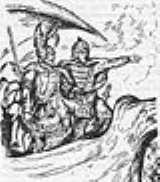
Rulers of Kievan Rus'
Overview
Kievan Rus'
Kievan Rus was a medieval polity in Eastern Europe, from the late 9th to the mid 13th century, when it disintegrated under the pressure of the Mongol invasion of 1237–1240....
in the 9th–12th centuries.
The Annals of St. Bertin (Annales Bertiniani
Annales Bertiniani
Annales Bertiniani, or The Annals of St. Bertin, are late Carolingian, Frankish annals that were found in the monastery of St. Bertin, after which they are named. Their account is taken to cover the period 830-82, thus continuing the Royal Frankish Annals , from which, however, it has circulated...
) for the year 839 became the first written record on the Rus'/Rhos. Louis the Pious
Louis the Pious
Louis the Pious , also called the Fair, and the Debonaire, was the King of Aquitaine from 781. He was also King of the Franks and co-Emperor with his father, Charlemagne, from 813...
, the Frankish emperor, came to the conclusion that the people called Rhos (qui se, id est gentem suum, Rhos vocari dicebant) belong to the gens of Swedes (eos gentis esse Sueonum).
Most of modern surveys of Rus' history narrate that in these Frankish annals the ruler of the Rhos/Rus (people of Swedish origin) was called chaganus (Latin form of the Turk word khaqan
Khagan
Khagan or qagan , alternatively spelled kagan, khaghan, qaghan, or chagan, is a title of imperial rank in the Mongolian and Turkic languages equal to the status of emperor and someone who rules a khaganate...
, or khagan, qaghan, qagan), similar to the Khazar chaqan (khaqan), a title of a prime ruler in the nomadic societies in Eurasia.
Yet the original Latin text, published by Georg Weitz in the Monumenta Germaniae Historica in 1883, contains a very significant difference from modern translations: it says the ruler of the Rhos was named not chaganus, but chacanus.

